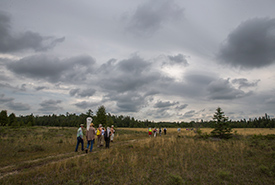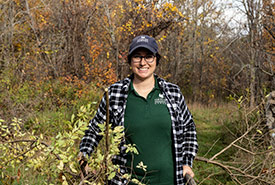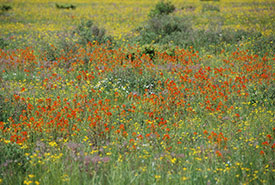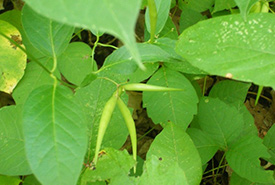Combating invasive species in a globally rare habitat

Leaders in Conservation in Carden Alvar, ON (Photo by NCC)
On a hot and humid day this past summer, I visited Carden Alvar in Ontario with a group of Nature Conservancy of Canada (NCC) Leaders in Conservation. We meandered through the forest and stepped onto the limestone plain alvar, which stretched on the property as far as the eye can see.
At first glance, the landscape appears quite barren, but Carden Alvar actually supports a staggering 142 butterfly and dragonfly species, 450 plant species and 238 bird species. Unfortunately, some of Ontario’s most aggressive invasive species have also found their way to this globally rare habitat.

Brittany Hope working in Carden Alvar, ON (Photo by NCC)
That’s why NCC, its local partners and community members have come together to share their expertise and efforts and take a collective approach to managing these invasive species through the Carden Alvar Invasive Species Control Program.
I caught up with NCC’s conservation biologist in the area, Brittany Hope, who told me more about the work she and others have been doing this year to keep Carden Alvar native.
Laura Vaughan (LV): What is the Carden Alvar Invasive Species Control Program?
Brittany Hope (BH): It’s really a collaborative approach to managing invasive species in this area. We know that we’re more successful in controlling these species when we all work together. Nature knows no boundaries and doesn’t care about property lines, so by sharing expertise and efforts we can be more successful in improving this rare habitat for the native species that rely on it.
LV: What partners is NCC working with as part of the program?

Flowers in Carden Alvar, ON (Photo by Bill Macintyre)
BH: We’re working with the Couchiching Conservancy and Ontario Parks, who are landowners and long-time partners of NCC in Carden Alvar. We also couldn’t do this work without the financial support from TD Friends of the Environment Foundation, Ontario Trillium Foundation and many individual and private donors.
LV: Tell me about some of the work you’ve been doing this past field season.
BH: Well, with our new GPS systems, we’ve been producing maps of invasive species populations, which are helping us act fast and create comprehensive plans for managing these populations.
We’ve also been fortunate to have some amazing volunteers from the community come out to help map and control invasive species on more than 200 acres (81 hectares) as part of NCC’s Conservation Volunteers program. I’ve had the chance to engage with the community at a couple of events, where I spoke about these invasive species, best practices and how everyone can help out.
LV: What species are you worried about in this area?

Dog-strangling vine seed pods (Photo by NCC)
BH: Dog-strangling vine (DSV) is a member of the milkweed family and grows aggressively in open, sunny areas, making it a perfect alvar invader. It can grow up to two metres high and wraps itself around trees and other vegetation, essentially “strangling” them. It also threatens monarch butterfly populations as they’re tricked into laying their eggs on the plant, but are then unable to complete their life cycle as they typically would on other milkweed species. Like many insects, monarchs have evolved close relationships with plants native to the region, and even slight differences in chemical composition can make the plant distasteful, or it may simply not provide the right suite of nutrients to allow the caterpillars to grow. As DSV evolved in eastern Europe, monarchs have not evolved to be able to eat it.
Invasive honeysuckle and common buckthorn rapidly invade an area and form dense patches. They block out light to neighbouring plants and release a toxin from their roots that prevents other plants from growing. These nasty invaders are making their way onto the alvar, so now is our opportunity to control them before they take over.
LV: What can community members do to help stop the spread of invasive species?
BH: There’s a lot that community members can do! Here are a few ways to help:
- Become familiar with the invasive species threatening your property and community, and learn how to effectively control them using the best management practices listed on the Ontario Invading Species Awareness Program website.
- Join a volunteer event put on by your local conservation group.
- Avoid using non-native plants in gardening or landscaping, and always buy from a reputable garden supplier. The Grow Me Instead guide has many options for gardening alternatives.
- If you find an invasive species, be sure to report it on the EDDMaps Ontario website or call the invading species hotline at 1-800-563-7711.


